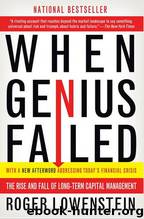When genuis failed by Roger Lowenstein

Author:Roger Lowenstein [Lowenstein, Roger]
Language: eng
Format: epub
Publisher: Random House Publishing Group
Published: 0101-01-01T00:00:00+00:00
▪
In June, Ron Tannenbaum, the UBS salesman who had pitched the warrant, left the bank—a footnote in the unfolding drama. Of greater import, credit spreads continued to widen. More frightening still, they widened in every market in which Long-Term was active. The trouble wasn't specific to any security; it was a general pulling back of credit, a pervasive sense that markets had been undercharging for risk. Investors wanted safety; now they would pay any amount to buy a Treasury (meaning that they would accept any lower yield, as long as they got out of riskier bonds).
Jim McEntee, J.M.'s friend and the one partner who relied on his nose, as distinct from a computer, sensed the trade-winds changing. He repeatedly urged his partners to lower the firm's risks, but McEntee was ignored as a nonscientific, old-fashioned gambler. Since moving to Connecticut, the partners, who no longer had to jostle with the throngs on Wall Street every day, had become even more isolated from the anecdotal, but occasionally useful, gossip that traders pass around. They found it easy to brush off McEntee's alarums, particularly since the Sheik's own trades had been losing money. Increasingly frustrated, McEntee met James Rickards, Long-Term's general counsel, after work one night at the Horseneck Tavern in Greenwich. Rickards was leaving the next morning on an expedition to climb Mount McKinley in Alaska. "By the time you get back, the world will have completely changed," McEntee predicted darkly.
All over Wall Street, McEntee's fellow traders were now speaking of a "flight to quality"—that is, to Treasury bonds. By mid-June, the yield on the thirty-year Treasury had fallen to 5.58 percent, the lowest since the government had started issuing thirty-year bonds in 1977. "Everyone in the [Treasury] market is afraid to go home short," Matthew Alexy, a strategist with Credit Suisse First Boston, told The Wall Street journal.'12 Except for Long-Term Capital, which went home short on Treasurys every day. Treasurys were the basic bond that the fund sold short to hedge the riskier bonds it owned. And as Treasurys rallied, spreads between them and other bonds widened. Mortgage-backed securities jumped from 96 basis points over Treasurys to 113 points. Corporate bonds rose from 99 to 105, and junk issues rose from 224 to 266. Even those sale seeming off-the-run Treasurys climbed from 6 points over to X points over." In every market, the premium demanded for riskier bonds increased. In every market, Long-Term was losing money.
Why this all-consuming fear of risk? Once again, Asia was the spark. In Japan, the yen was plummeting, accentuating the country's already deep recession. Japanese bond yields were plummeting — exactly the opposite of Long-Term's bet. And Japan was the cornerstone of the East Asian economy. With Japanese importers scaling back their purchases, there was talk of a regional depression. In Indonesia, the rupiah had lost 85 percent of its precrisis value. In South Korea, stocks plunged 8 percent in a single day. The fear was pervasive, but every day, it emerged in a different place.
Download
This site does not store any files on its server. We only index and link to content provided by other sites. Please contact the content providers to delete copyright contents if any and email us, we'll remove relevant links or contents immediately.
International Integration of the Brazilian Economy by Elias C. Grivoyannis(74719)
The Radium Girls by Kate Moore(11621)
Turbulence by E. J. Noyes(7700)
Nudge - Improving Decisions about Health, Wealth, and Happiness by Thaler Sunstein(7242)
The Black Swan by Nassim Nicholas Taleb(6763)
Rich Dad Poor Dad by Robert T. Kiyosaki(6174)
Pioneering Portfolio Management by David F. Swensen(6078)
Man-made Catastrophes and Risk Information Concealment by Dmitry Chernov & Didier Sornette(5646)
Zero to One by Peter Thiel(5488)
Secrecy World by Jake Bernstein(4388)
Millionaire: The Philanderer, Gambler, and Duelist Who Invented Modern Finance by Janet Gleeson(4093)
The Age of Surveillance Capitalism by Shoshana Zuboff(3983)
Skin in the Game by Nassim Nicholas Taleb(3965)
The Money Culture by Michael Lewis(3846)
Bullshit Jobs by David Graeber(3828)
Skin in the Game: Hidden Asymmetries in Daily Life by Nassim Nicholas Taleb(3722)
The Dhandho Investor by Mohnish Pabrai(3560)
The Wisdom of Finance by Mihir Desai(3523)
Blockchain Basics by Daniel Drescher(3329)
